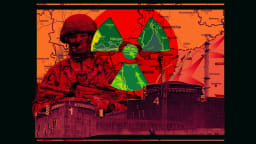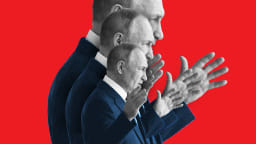DEFCON ONE
A nuclear superpower didn’t descend into chaos. What happens the next time?
Joseph Cirincione
Contributing Writer
THE DAILY BEAST
Published Jun. 25, 2023
We dodged a nuclear bullet. The Prigozhin rebellion is over for now. Russia’s nuclear forces are under control. But it gave us another chilling reminder of how weapons we believe provide our ultimate security can quickly become our ultimate danger.
Russia has the largest nuclear arsenal in the world, with some 5,900 weapons, most capable of destroying a city. The use of one or two would be a catastrophe. Ten would be a level of destruction never before seen in human history. A hundred or more would bring the end of civilization.
There were four major nuclear risks during this 24-hour coup. Two unlikely; two very real.
Ukraine’s Ticking Nuclear Time Bomb
PUTIN’S MELTDOWN
Joseph Cirincione

The first was that Wagner Group leader Yevgeny Prigozhin would seize some of Russia’s nuclear weapons. This was highly unlikely.
As Carnegie Endowment nuclear expert James Acton points out, all Russian nuclear weapons are equipped with use controls, requiring codes to unlock. Even if he gained access to them, how would he use them? Whomever used Russian weapons on Russian people would immediately become a national pariah.
The second was that Vladimir Putin would use them against the rebels. He has command of the codes and weapons (though some believe he may need the concurrence of the defense minister or military chief to launch them). But he, too, would face the same problem as Prigozhin. Despite his repeated nuclear threats, even Putin understands that the weapons don’t have much military purpose and their use would discredit the user.
More serious was the risk of the collapse of the state, and with it, the system of nuclear command and control. Only once before in history has the world faced the prospect of a nuclear-armed nation descending into chaos. That was in the August 1991 attempted coup against Soviet President Mikhail Gorbachev. It, too, failed.
But when the Soviet Union collapsed a few months later, there was immediate concern: Who gets the weapons? Who gets the material used to build the weapons? What happens to the scientists who know how to build the weapons?
Don’t Panic About Putin’s Nuclear Saber-Rattling
STEP AWAY FROM THE BUTTON
Joseph Cirincione

At that time, the U.S. and Russia were on good terms. A concerted, well-funded U.S. effort led to the greatest cooperative nuclear reductions in history, including the removal and destruction of thousands of weapons from Belarus, Ukraine, and Kazakhstan.
With Putin now gravely weakened, the Russian state again appears unstable. But there is no guarantee that such an effort could be repeated. A nuclear black market could spread weapons, material and scientists to the far corners of the globe.
The final terror was that an insane Putin might explode the weapons in revenge. If the coup succeeded and he was going down, would he take the nation down with him? Or worse? A nuclear version of Hitler in the bunker asking “Is Paris burning?”
As in all nine nuclear-armed states, the decision to launch nuclear weapons is left to one or two leaders. There is no democracy in nuclear use. No vote required. No debate. No court decision can block it. The military is drilled daily to follow a launch order immediately, without question. Only a far greater mutiny than we saw June 24 could prevent it.
Although there have been dozens of computer and machine failures that brought us perilously close to mistaken nuclear launches over the decades, the weakest link in the nuclear command and control chain remains the humans who manage them. Many of these leaders have been considered mentally unbalanced, including in our country. It takes a committed optimist to believe that we can leave thousands of nuclear weapons in fallible human hands indefinitely and something terrible won’t happen.
Something terrible will happen. It just didn’t happen this time.
Presidential efforts under John Kennedy, Ronald Reagan, and Barack Obama sought to end this danger by eliminating nuclear weapons. They all reasoned that risks like those we just experienced are too serious to endure. “The weapons of war must be abolished,” Kennedy said, “before they abolish us.”
Their efforts were blocked by men insisting we need nuclear weapons for protection, despite national arsenals brimming with conventional arms.
If we get another leader like these previous presidents, if we get another chance, we would be well to recall how close to the nuclear brink Prigozhin’s unexpected march on Moscow brought us.
Published Jun. 25, 2023
OPINION
We dodged a nuclear bullet. The Prigozhin rebellion is over for now. Russia’s nuclear forces are under control. But it gave us another chilling reminder of how weapons we believe provide our ultimate security can quickly become our ultimate danger.
Russia has the largest nuclear arsenal in the world, with some 5,900 weapons, most capable of destroying a city. The use of one or two would be a catastrophe. Ten would be a level of destruction never before seen in human history. A hundred or more would bring the end of civilization.
There were four major nuclear risks during this 24-hour coup. Two unlikely; two very real.
Ukraine’s Ticking Nuclear Time Bomb
PUTIN’S MELTDOWN
Joseph Cirincione

The first was that Wagner Group leader Yevgeny Prigozhin would seize some of Russia’s nuclear weapons. This was highly unlikely.
As Carnegie Endowment nuclear expert James Acton points out, all Russian nuclear weapons are equipped with use controls, requiring codes to unlock. Even if he gained access to them, how would he use them? Whomever used Russian weapons on Russian people would immediately become a national pariah.
The second was that Vladimir Putin would use them against the rebels. He has command of the codes and weapons (though some believe he may need the concurrence of the defense minister or military chief to launch them). But he, too, would face the same problem as Prigozhin. Despite his repeated nuclear threats, even Putin understands that the weapons don’t have much military purpose and their use would discredit the user.
More serious was the risk of the collapse of the state, and with it, the system of nuclear command and control. Only once before in history has the world faced the prospect of a nuclear-armed nation descending into chaos. That was in the August 1991 attempted coup against Soviet President Mikhail Gorbachev. It, too, failed.
But when the Soviet Union collapsed a few months later, there was immediate concern: Who gets the weapons? Who gets the material used to build the weapons? What happens to the scientists who know how to build the weapons?
Don’t Panic About Putin’s Nuclear Saber-Rattling
STEP AWAY FROM THE BUTTON
Joseph Cirincione

At that time, the U.S. and Russia were on good terms. A concerted, well-funded U.S. effort led to the greatest cooperative nuclear reductions in history, including the removal and destruction of thousands of weapons from Belarus, Ukraine, and Kazakhstan.
With Putin now gravely weakened, the Russian state again appears unstable. But there is no guarantee that such an effort could be repeated. A nuclear black market could spread weapons, material and scientists to the far corners of the globe.
The final terror was that an insane Putin might explode the weapons in revenge. If the coup succeeded and he was going down, would he take the nation down with him? Or worse? A nuclear version of Hitler in the bunker asking “Is Paris burning?”
As in all nine nuclear-armed states, the decision to launch nuclear weapons is left to one or two leaders. There is no democracy in nuclear use. No vote required. No debate. No court decision can block it. The military is drilled daily to follow a launch order immediately, without question. Only a far greater mutiny than we saw June 24 could prevent it.
Although there have been dozens of computer and machine failures that brought us perilously close to mistaken nuclear launches over the decades, the weakest link in the nuclear command and control chain remains the humans who manage them. Many of these leaders have been considered mentally unbalanced, including in our country. It takes a committed optimist to believe that we can leave thousands of nuclear weapons in fallible human hands indefinitely and something terrible won’t happen.
Something terrible will happen. It just didn’t happen this time.
Presidential efforts under John Kennedy, Ronald Reagan, and Barack Obama sought to end this danger by eliminating nuclear weapons. They all reasoned that risks like those we just experienced are too serious to endure. “The weapons of war must be abolished,” Kennedy said, “before they abolish us.”
Their efforts were blocked by men insisting we need nuclear weapons for protection, despite national arsenals brimming with conventional arms.
If we get another leader like these previous presidents, if we get another chance, we would be well to recall how close to the nuclear brink Prigozhin’s unexpected march on Moscow brought us.

No comments:
Post a Comment